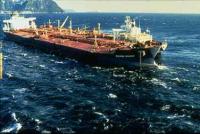 On March 24, 1989, the 210,000 dwt crude oil tanker Exxon Valdez sailed from Valdez Marine Terminal and entered Alaska’s Prince William Sound. At 12:04 am, the single hulled ship ran aground on Bligh Reef, resulting in the largest oil spill in United States history, prior to the Deepwater Horizon disaster. Between 260,000 to 750,000 barrels (41,000 to 119,000 m3) of crude oil spilled into the Sound. The oil eventually covered 1,300 miles (2,100 km) of coastline, and 11,000 square miles (28,000 km2) of ocean.
On March 24, 1989, the 210,000 dwt crude oil tanker Exxon Valdez sailed from Valdez Marine Terminal and entered Alaska’s Prince William Sound. At 12:04 am, the single hulled ship ran aground on Bligh Reef, resulting in the largest oil spill in United States history, prior to the Deepwater Horizon disaster. Between 260,000 to 750,000 barrels (41,000 to 119,000 m3) of crude oil spilled into the Sound. The oil eventually covered 1,300 miles (2,100 km) of coastline, and 11,000 square miles (28,000 km2) of ocean.
Shipping often seems to make progress only by responding to disaster. The Scilly naval disaster, which sank four large ships and claimed the lives of more than 1,400 sailors, due to poor navigation in 1707, lead directly to the Longitude Act 1714 which 50 years later led to the development of a marine chronometer with which to calculate longitude. The sinking of the RMS Titanic with the loss of of more than 1,500 passengers and crew, lead to the first International Convention for the Safety of Life at Sea (SOLAS) in 1974. SOLAS continues to be the primary framework for ship safety regulations to this day.
The Oil Pollution Act of 1990 (OPA90) was enacted as a direct response to the Exxon Valdez spill. In addition to new and enhanced casualty response requirements, OPA90 mandated double hulls on tankers trading with the US, which lead directly to a phased world-wide ban on single hull tankers. One study suggests that double hulls on tankers reduce the size of oil spills by 62% on average.
